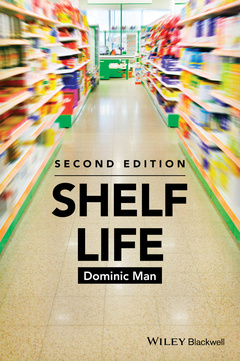Description
Shelf Life (2nd Ed.)
Author: Man Dominic
Language: English
Subjects for Shelf Life:
160 p. · 15.1x23 cm · Paperback
Description
/li>Contents
/li>Biography
/li>
Shelf life, a term recognised in EU/UK food legislation, may be defined as the period of time for which a food product will remain safe and fit for use, provided that it is kept in defined storage conditions. During this period, the product should retain its desired sensory, chemical, physical, functional and microbiological characteristics, as well as accurately comply with any nutritional information printed on the label. ?Shelf life? therefore refers to a number of different aspects; each food product has a microbiological shelf life, a chemical shelf life, and a sensory (or organoleptic) shelf life. These categories reflect the different ways in which a food product will deteriorate over time. Ultimately the shelf life of a food product is intended to reflect the overall effect of these different aspects.
Shelf life has always been an important facet of industrial food preparation and production, as food and drink are often produced in one area and then distributed to other areas for retailing and consumption. Globalised distribution and supply chains make it imperative that food should survive the transit between producer and consumer as a perishable commodity, food carries a high risk of spoilage. As such, a realistic, workable and reproducible shelf life has to be determined every time a new food product is developed and marketed; shelf life determination of food has become an integral part of food safety, quality assurance, product development, marketing, and consumer behaviour.
Dominic Man?s Shelf Life, now in a revised and updated second edition, encompasses the core considerations about shelf life. Section 1 introduces shelf life, describes its relationship to food safety, and provides answers to the frequently asked questions around shelf life determination and testing which are a manager?s chief concerns. Section 2 covers the science of the various ways in which food deteriorates and spoils, including the physical, chemical and microbiological changes. Section 3 looks at shelf life in practice, using case studies of different products to illustrate how shelf life may be determined in real life settings. This book will be invaluable to both practitioners and students in need of a succinct and comprehensive overview of shelf life concerns and topics.
Preface to the Second Edition ix
Preface to the First Edition xi
Section 1 Introduction to shelf life of foods – Frequently asked questions 1
1.1 What is shelf life? 1
1.2 Why are food safety and shelf life related? 2
1.3 Who should be interested in shelf life of foods? 5
1.4 Who is responsible for determining shelf life? 6
1.5 Is it illegal to give a wrong shelf life to a food product? 7
1.6 How long a shelf life should my product have? 10
1.7 What is accelerated shelf life testing? 12
1.8 What are the resources required for determining shelf life? 15
1.9 How is the end of shelf life normally decided? 16
1.10 How do we ensure that the shelf lives established for our products are accurate and reproducible? 17
1.11 Can mathematical/computer models help in shelf life determinations? 20
1.12 What is challenge testing? 30
1.13 Can the shelf life of my product be extended? 31
1.14 How are storage tests and trials set up for determining shelf life? 36
1.14.1 Objective of the storage trial 36
1.14.2 Storage conditions 36
1.14.3 Samples for storage trials 37
1.14.4 Sampling schedule 38
1.14.5 Shelf life tests 38
1.15 Food waste and shelf life: What is the problem? 39
1.16 Summary 40
Section 2 The ways food deteriorates and spoils 41
2.1 Mechanisms of food deterioration and spoilage 41
2.1.1 Physical changes and mechanisms 41
2.1.2 Chemical and/or biochemical changes 46
2.1.3 Light‐induced changes 57
2.1.4 Microbiological changes 58
2.2 Factors influencing the shelf life of foods 62
2.2.1 Intrinsic factors 62
2.2.2 Extrinsic factors 71
2.2.3 Interaction between intrinsic and extrinsic factors 76
2.2.4 Consumer handling and use 76
2.2.5 Commercial considerations 77
2.3 Summary 77
Section 3 Determining shelf life in practice 79
3.1 Case study 1 – chilled recipe dish 79
3.1.1 The product 79
3.1.2 The process 79
3.1.3 Food safety 80
3.1.4 Mechanism(s) of shelf life deterioration 81
3.1.5 Shelf life determination – storage trials 81
3.1.6 Predicting shelf life 82
3.1.7 Assurance of assigned shelf life – the HACCP approach 82
3.2 Case study 2 – savoury potato snack 83
3.2.1 The product 83
3.2.2 The process 83
3.2.3 Food safety 83
3.2.4 Mechanism(s) of shelf life deterioration 84
3.2.5 Shelf life determination – storage trials 85
3.2.6 Assurance of assigned shelf life – the HACCP approach 86
3.3 Case study 3 – carbonated soft drink 86
3.3.1 The product 86
3.3.2 The process 87
3.3.3 Food safety 88
3.3.4 Mechanism(s) of shelf life determination 88
3.3.5 Shelf life determination – storage trials 88
3.3.6 Assurance of assigned shelf life – the HACCP approach 89
3.4 Case study 4 – condiment sauce 91
3.4.1 The product 91
3.4.2 The process 91
3.4.3 Food safety 91
3.4.4 Mechanism(s) of shelf life deterioration 91
3.4.5 Shelf life determination – storage trials 93
3.4.6 Assurance of assigned shelf life – the HACCP approach 94
3.5 Case study 5 – frozen baked cake 95
3.5.1 The product 95
3.5.2 The process 95
3.5.3 Food safety 95
3.5.4 Mechanisms(s) of shelf life deterioration 95
3.5.5 Shelf life determination – storage trials 96
3.5.6 Assurance of assigned shelf life – the HACCP approach 97
3.6 Summary 98
Epilogue 101
Appendix A: The Arrhenius model 109
Appendix B: The CIMSCEE formulae for microbiological safety and stability 111
References 115
Index 131

